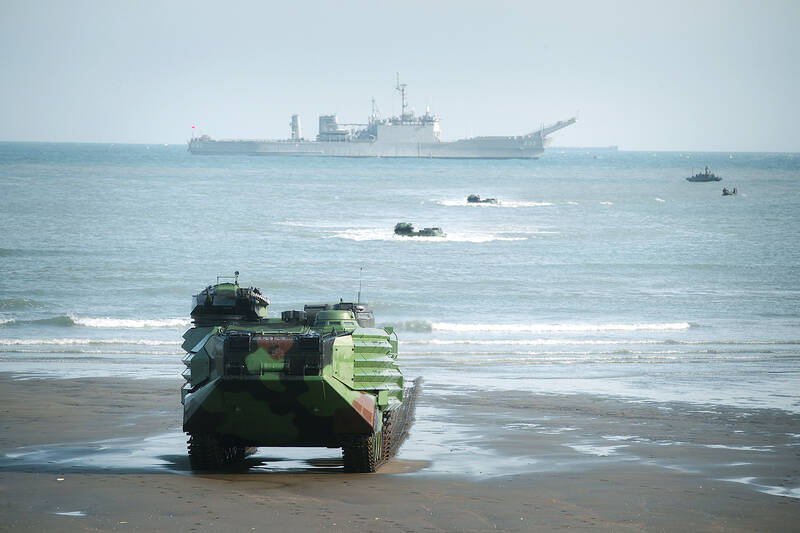The armed forces are to hold field exercises on Monday and Tuesday in coastal regions dubbed “red beaches” to train defending Taiwan proper against a multipronged amphibious attack, a defense official familiar with the matter said, speaking on condition of anonymity.
Live-fire drills are to be conducted on beaches and near shores in New Taipei City’s Tamsui District (淡水), at the Port of Taipei and in Taoyuan’s Guanyin District (觀音), a notice posted on the bulletin of the Fisheries Administration said.
The official said the exercises would test the army’s ability to react quickly and utilize mobile reserves to defend simultaneous attacks by the Chinese military on multiple fronts.

Photo: CNA
In the war game, the Sixth Army Corps would play the defending force and the 151st Fleet would be the aggressor, the official added.
If Beijing were to invade Taiwan, the Chinese military would attack in multiple coastal areas, as few beaches in Taiwan proper are suitable landing sites for amphibious operations, they said.
The field exercises are scheduled to begin the same day as the computer-assisted simulation component of the annual Han Kuang drills, which would conclude on Friday next week, the official said,
Findings from past tabletop exercises and trends seen in the Russia-Ukraine war would be incorporated into the computer-assisted portion of the drills, which would be based on the Joint Theater Level Simulation technology platform, the official said.
The possible landing sites for the Chinese military are dubbed “red beaches” among military analysts, they said.
In 2017, Ian Easton, now senior director at the US-based Project 2049 Institute, identified 14 vulnerable beaches that could be used as landing sites, the official said.
The Taiwanese armed forces recognize that such vulnerabilities exist, but do not agree with Easton’s assessment of their locations and number, they said.
Separately, the Ministry of National Defense last week told lawmakers that the army plans to buy 2,060 light machine guns for combat units for NT$428.9 million (US$13.94 million) over five years.
The weapons would be allocated to enhance frontline units’ firepower and their capability to conduct counterattacks against Chinese amphibious and airborne, air assault, infiltration and sabotage operations, it said.
A public version of the ministry’s proposed budget revealed a flurry of plans to buy arms and equipment amid a planned expansion of the army and marine corps following the implementation of one-year military conscription and the expansion of the reserves.
The budget proposals include NT$521 million for grenade launchers, automatic grenade launchers and pistols; NT$108 million for 107 81mm mortars; NT$232.2 million for chemical, biological, radiological and nuclear protective equipment; NT$1.759 billion for 10,000 night vision devices; and NT$22.8 million for 2,000 binoculars.

LIMITS: While China increases military pressure on Taiwan and expands its use of cognitive warfare, it is unwilling to target tech supply chains, the report said US and Taiwan military officials have warned that the Chinese People’s Liberation Army (PLA) could implement a blockade within “a matter of hours” and need only “minimal conversion time” prior to an attack on Taiwan, a report released on Tuesday by the US Senate’s China Economic and Security Review Commission said. “While there is no indication that China is planning an imminent attack, the United States and its allies and partners can no longer assume that a Taiwan contingency is a distant possibility for which they would have ample time to prepare,” it said. The commission made the comments in its annual

DETERMINATION: Beijing’s actions toward Tokyo have drawn international attention, but would likely bolster regional coordination and defense networks, the report said Japanese Prime Minister Sanae Takaichi’s administration is likely to prioritize security reforms and deterrence in the face of recent “hybrid” threats from China, the National Security Bureau (NSB) said. The bureau made the assessment in a written report to the Legislative Yuan ahead of an oral report and questions-and-answers session at the legislature’s Foreign Affairs and National Defense Committee tomorrow. The key points of Japan’s security reforms would be to reinforce security cooperation with the US, including enhancing defense deployment in the first island chain, pushing forward the integrated command and operations of the Japan Self-Defense Forces and US Forces Japan, as

‘TROUBLEMAKER’: Most countries believe that it is China — rather than Taiwan — that is undermining regional peace and stability with its coercive tactics, the president said China should restrain itself and refrain from being a troublemaker that sabotages peace and stability in the Indo-Pacific region, President William Lai (賴清德) said yesterday. Lai made the remarks after China Coast Guard vessels sailed into disputed waters off the Senkaku Islands — known as the Diaoyutai Islands (釣魚台) in Taiwan — following a remark Japanese Prime Minister Sanae Takaichi made regarding Taiwan. Takaichi during a parliamentary session on Nov. 7 said that a “Taiwan contingency” involving a Chinese naval blockade could qualify as a “survival-threatening situation” for Japan, and trigger Tokyo’s deployment of its military for defense. Asked about the escalating tensions

The Ministry of Economic Affairs said it plans to revise the export control list for strategic high-tech products by adding 18 items under three categories — advanced 3D printing equipment, advanced semiconductor equipment and quantum computers — which would require local manufacturers to obtain licenses for their export. The ministry’s announcement yesterday came as the International Trade Administration issued a 60-day preview period for planned revisions to the Export Control List for Dual Use Items and Technology (軍商兩用貨品及技術出口管制清單) and the Common Military List (一般軍用貨品清單), which fall under regulations governing export destinations for strategic high-tech commodities and specific strategic high-tech commodities. The